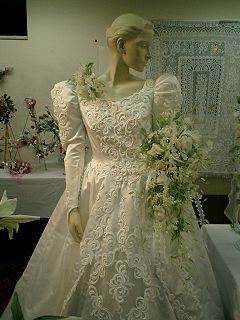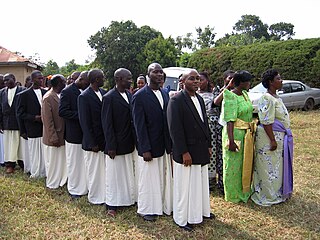
A wedding cake topper is a small model that sits on top of a wedding cake, normally a representation of the couple in formal wedding attire.

A wedding cake topper is a small model that sits on top of a wedding cake, normally a representation of the couple in formal wedding attire.
The wedding cake topper was dominant in United States weddings in the 1950s where it represented togetherness. [1] Today, these decorative figurines are often part of the couple's decorative theme or wedding reception style. [2] [3]
While traditionally the bride and groom were in formal attire, with the bride in a white wedding dress, complete with veil, and the groom in black morning dress, [4] today there are many more designs available. [3] There are specific ones for the style and theme of the wedding, for instance, traditional toppers for a formal wedding, and for less formal ones, there are comical wedding cake toppers or ones depending on the couple's hobbies. [3]
In recent times, wedding cake toppers have reflected the growing diversity in marriages. Multi-ethnic wedding toppers are now available, [5] [6] as are same-sex wedding toppers. [7] [8]

A wedding is a ceremony where two people are united in marriage. Wedding traditions and customs vary greatly between cultures, ethnic groups, religions, countries, and social classes. Most wedding ceremonies involve an exchange of marriage vows by a couple, presentation of a gift, and a public proclamation of marriage by an authority figure or celebrant. Special wedding garments are often worn, and the ceremony is sometimes followed by a wedding reception. Music, poetry, prayers, or readings from religious texts or literature are also commonly incorporated into the ceremony, as well as superstitious customs.
A white wedding is a traditional formal or semi-formal wedding originating in Great Britain.

A wedding reception is a party usually held after the completion of a marriage ceremony as hospitality for those who have attended the wedding, hence the name reception: the couple receive society, in the form of family and friends, for the first time as a married couple. Hosts provide their choice of food and drink, although a wedding cake is popular.

A bride is a woman who is about to be married or who is newlywed.

A wedding cake is the traditional cake served at wedding receptions following dinner. In some parts of England, the wedding cake is served at a wedding breakfast; the 'wedding breakfast' does not mean the meal will be held in the morning, but at a time following the ceremony on the same day. In modern Western culture, the cake is usually on display and served to guests at the reception. Traditionally, wedding cakes were made to bring good luck to all guests and the couple. Nowadays, however, they are more of a centerpiece to the wedding and are not always even served to the guests. Some cakes are built with only a single edible tier for the bride and groom to share, but this is rare since the cost difference between fake and real tiers is minimal.

A wedding dress or bridal gown is the dress worn by the bride during a wedding ceremony. The color, style and ceremonial importance of the gown can depend on the religion and culture of the wedding participants. In Western cultures and Anglo-Saxon cultural spheres, the wedding dress is most commonly white, a fashion made popular by Queen Victoria when she married in 1840. In Eastern cultures, brides often choose red to symbolize auspiciousness.

A corsage is a small bouquet of flowers worn on a woman's dress or around her wrist for a formal occasion. They are typically given to her by her date. Today, corsages are most commonly seen at homecomings, proms, and similar formal events.

The traditional Vietnamese wedding is one of the most important ceremonies in Vietnamese culture, which is influenced by Confucian and Buddhist ideologies.
A Brunei Malay wedding has many types of ceremonies.
Icelandic weddings today still observe some traditional customs, such as seating by gender and the high table.

A saber arch is a wedding tradition in which sabers or swords are used to salute a newly married couple. The bride and groom pass under an honorary arch of sabers, typically when exiting the building in which the wedding ceremony took place. The tradition is in use worldwide.
Whose Wedding Is It Anyway? is an American reality TV show on the Style Network. Season 1 began in 2003, Tuesdays, 10 p.m. Each episode runs 60 minutes and follows two different couples who plan their weddings in different states and sometimes a destination wedding in a foreign country.

Arabic weddings have changed greatly in the past 100 years. Traditional Arabic weddings are intended to be very similar to modern-day Bedouin weddings and rural weddings. What is sometimes called a "Bedouin" wedding is in fact the traditional Arab Islamic wedding without foreign influence. The ceremonies are in some cases unique from one region to another, even within the same country.

A kanzu is a white or cream coloured robe worn by men in the African Great Lakes region. It is referred to as a tunic in English, and as the Thawb in Arab countries. The kanzu is an ankle or floor length garment. It serves as the national costume of Tanzania as well as the Comoros, where it is called/pronounced 'Kandu' as well as thawb. The robe is also worn in some coastal Muslim regions of Tanzania and Kenya. The men of Uganda consider it their most important dress. Kanzu is a Ganda word of Swahili origin, which means "robe" or "tunic". In Tanzania, the term is used interchangeably with kaftan.
Weddings in the United States and Canada follow traditions often based on religion, culture, and social norms. Most wedding traditions in the United States and Canada were assimilated from other, generally European, countries. Marriages in the U.S. and Canada are typically arranged by the participants and ceremonies may either be religious or civil. There is a tradition that the prospective bridegroom ask his future father-in-law for his blessing.

Indian wedding clothes are elaborate set of clothes worn by the bride, bridegroom and other relatives attending the wedding.

The national costume of Indonesia is the national costume that represents the Republic of Indonesia. It is derived from Indonesian culture and Indonesian traditional textile traditions. Today the most widely recognized Indonesian national costumes include batik and kebaya, although originally those costumes mainly belong within the island of Java and Bali, most prominently within Javanese, Sundanese and Balinese culture. Since Java has been the political and population center of Indonesia, folk costume from the island has become elevated into national status.
Shinto weddings, Shinzen kekkon, began in Japan during the early 20th century, popularized after the marriage of Crown Prince Yoshihito and his bride, Princess Kujo Sadako. The ceremony relies heavily on Shinto themes of purification, and involves ceremonial sake drinking of three cups three times, the nan-nan-san-ku-do. Shinto weddings are in decline. Fewer Japanese people get married, and those who do often choose Western-style chapel ceremonies.

Weddings in Mali involve various important customs and celebrations spread out through a number of days. Usually, the groom and the bride do not personally know the attendees that come to the wedding festivity, because Malian families tend to be very big due to polygamy. Thus weddings are a perfect occasion for all the extended family members of the couple to come for the big day. Wedding ceremonies in Bamako are a time when the community comes together to support the bride and groom's family. During this time food is given, and family from the village come to say goodbye to the bride-to-be and celebrate with the family.